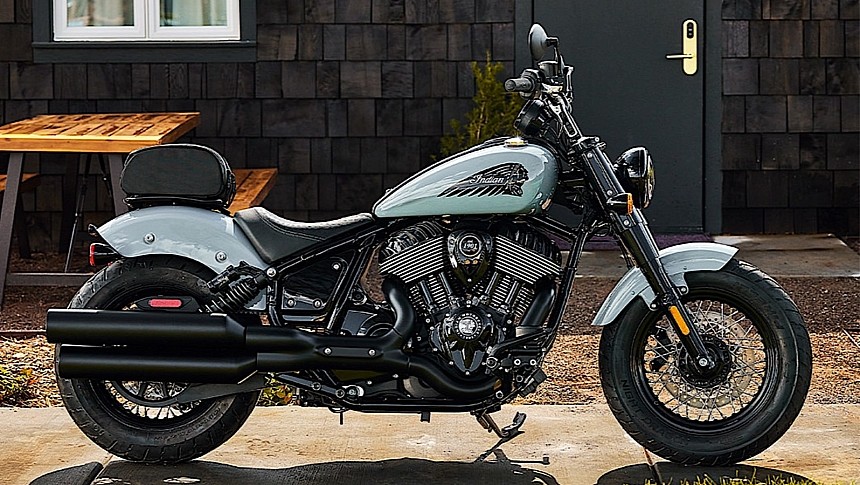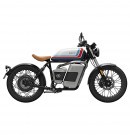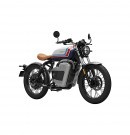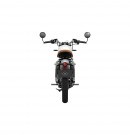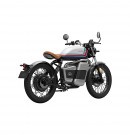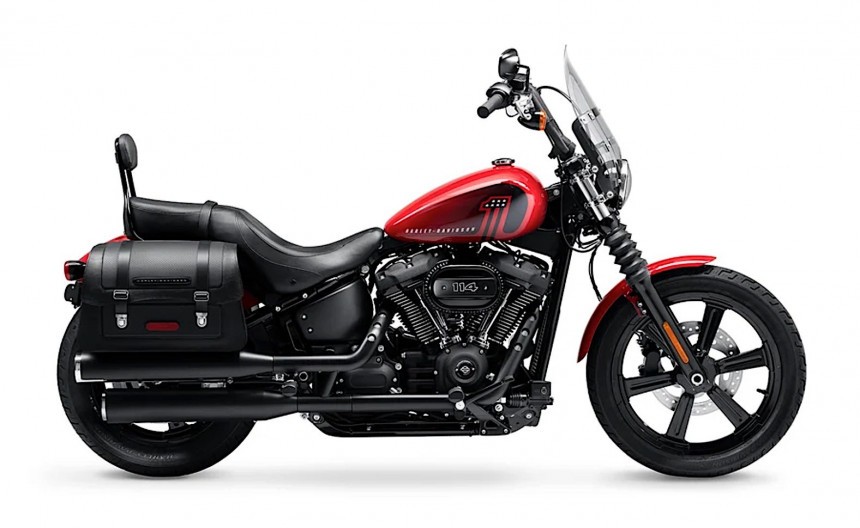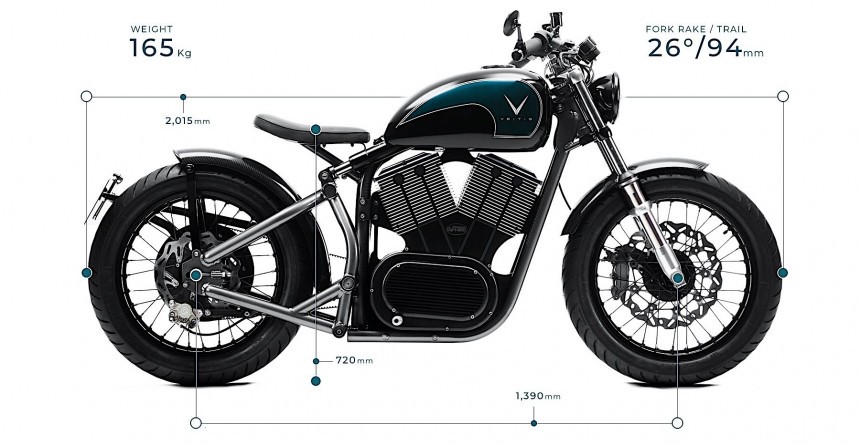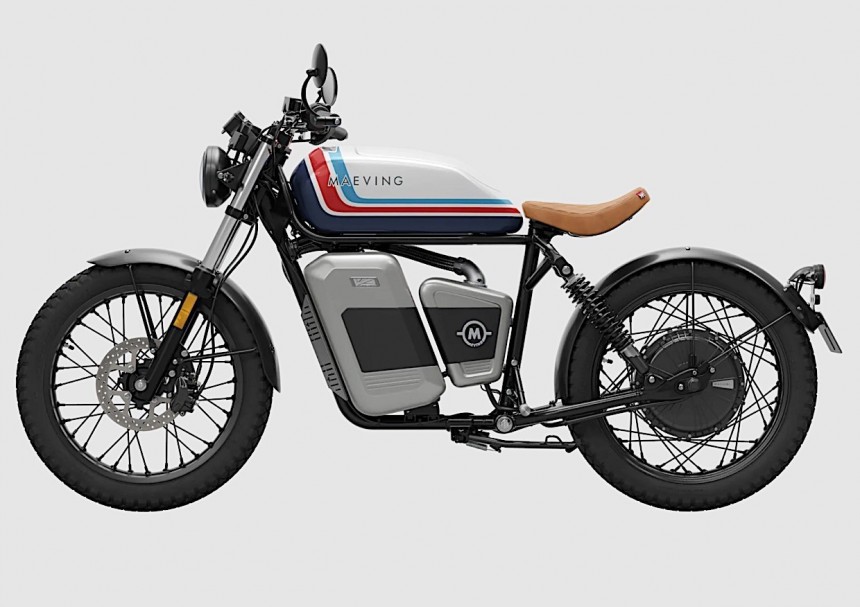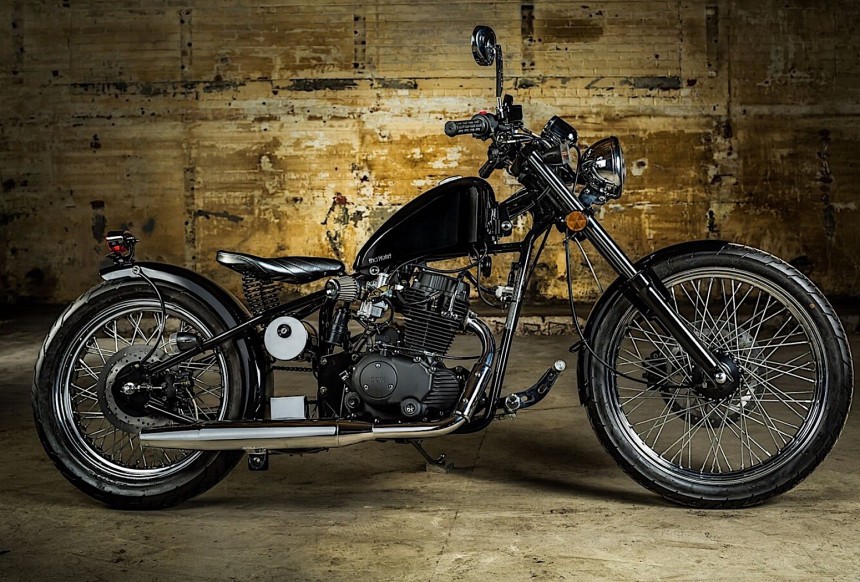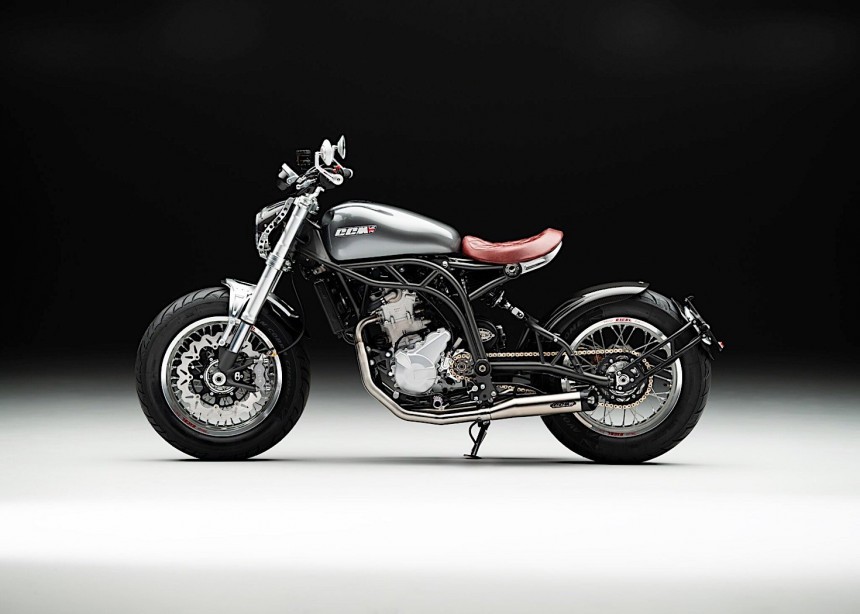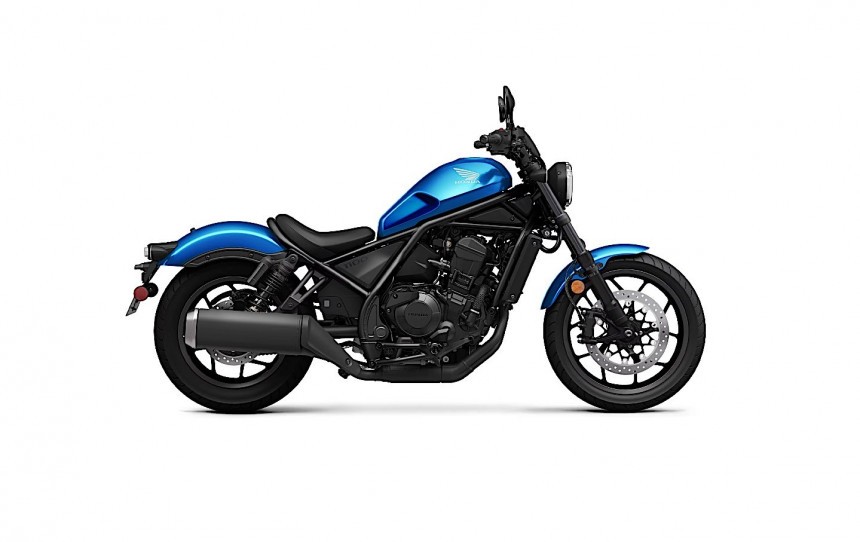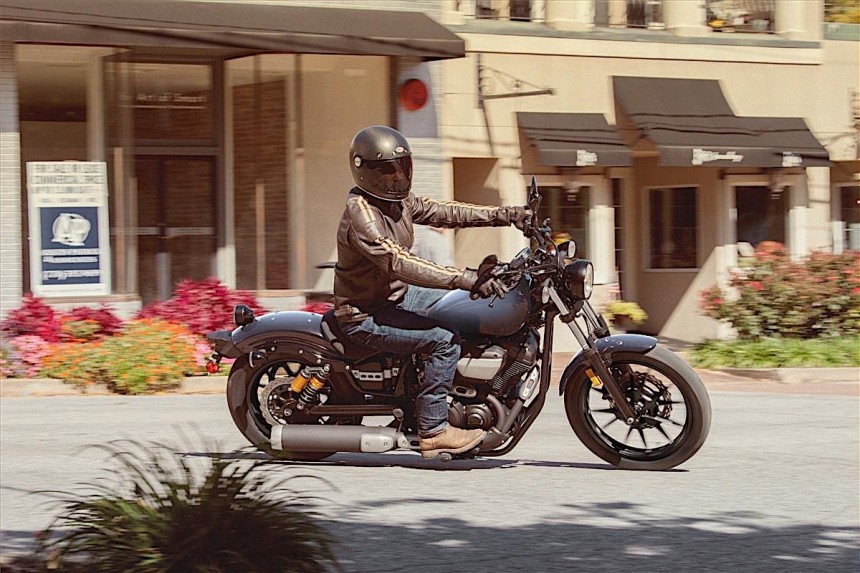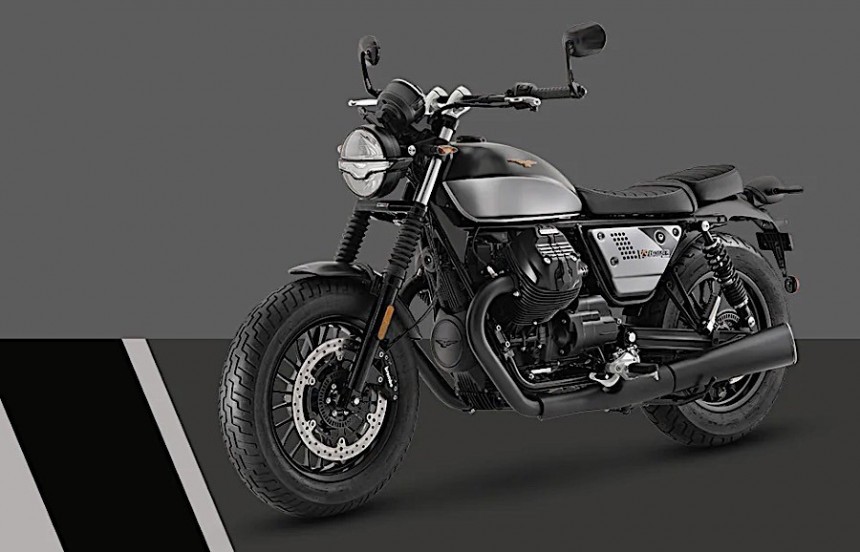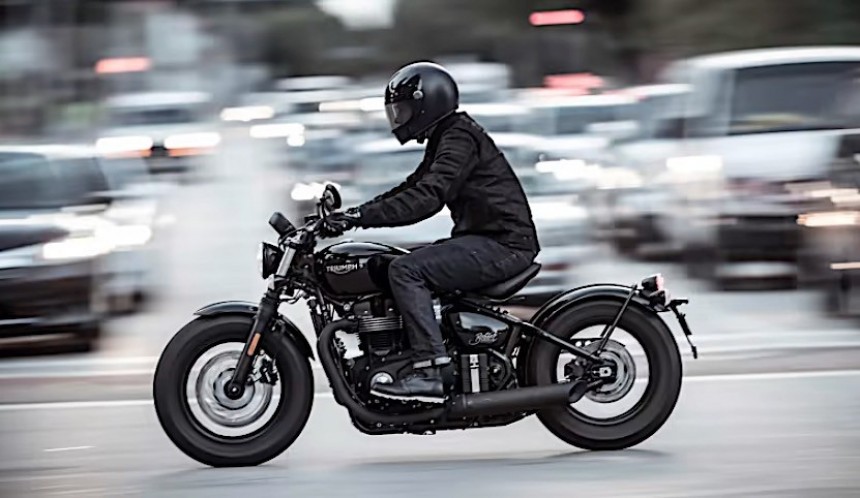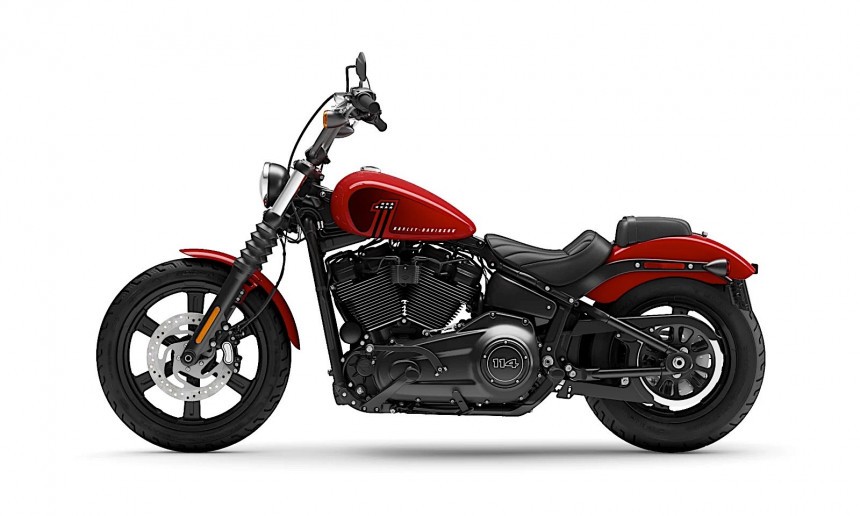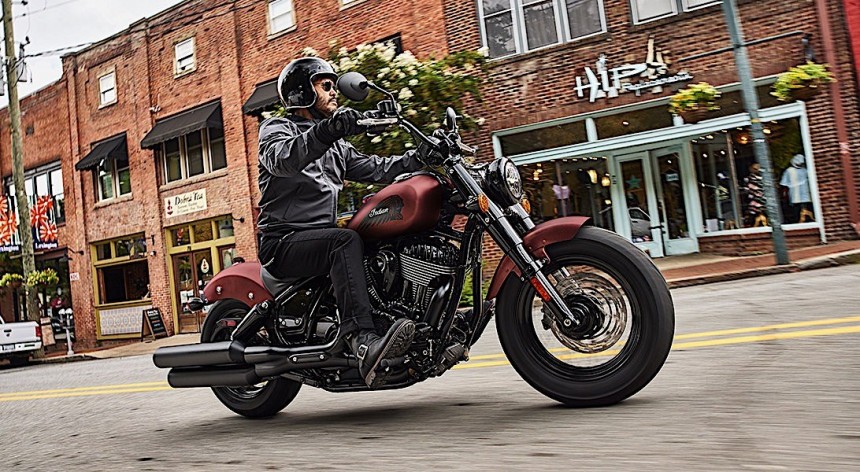Unlike what is happening in the car world, the motorcycle-making industry is very open to suggestions coming from customers. What that means is that whereas a carmaker will always resist adopting custom car styles and turning them into production vehicles, bike makers are a lot more malleable, and have always done this.
History is filled with instances when custom bike styles were turned into production hits. So much so that it sometimes feels all it takes for that to happen is for a not-that-large group of people to perform any kind of mildly successful modification to their two-wheelers.
History books show how moto companies have adapted their offering to include café racers, choppers, scramblers, streetfighters, you name it. Of particular interest to our story today is a style called bobber, something that was all the craze decades ago, but seems to enjoy a boost in popularity in today's market as well.
What is a bobber, you ask? Well, we're essentially talking about a two-wheeler that flaunts no unnecessary parts in a bid to become lighter. Why is that so? Simply because bobbers were born in the motorcycle racing world, and we all know weight is a performance killer there.
Bobber is a term derived from bob-job, which, back in the 1930s, was used to designate stripped-down motorcycles used for racing. By stripped-down I mean they had no fenders (or at most a very short one at the back) and no bodywork that was not somehow needed for the motorcycle to work properly.
The style was initially born in the 1930s in the custom industry in response to the American Motorcyclist Association (AMA) greenlighting Class C racing. There is no certain individual credited with having come up with this idea of losing body parts to drop weight, but we do know the very first bobbers were Indians and Harley-Davidsons.
The initial bobbers, aside from being stripped-down, lacked the bling of road-going motorcycles, even if that's what they were used for. That means they came as simple as they got, without a paint job, no chrome or other shiny metals, and generally looked bad.
As the style evolved, so did the way it manifested itself on builds. Starting with the 1950s and thanks to a guy named Kenneth Howard of Kustom Kulture fame, bobbers started to turn into real lookers, not only thanks to the inclusion of paint jobs, but also thanks to modifications made to the bike parts that always stayed on: the fuel tank, the seat, the handlebars, the exhaust, you name it.
For most of the style's existence bobbers only came about as a result of private efforts. In the 1990s, however, the bike-making establishment took note, and the big names of the game, starting with Harley-Davidson and Honda, started rolling out production bobbers.
This list of ours tries to bring together all the production bobber bikes we feel are worth something in 2023. These are, if you will, the official bobber bikes meant to fight off the incredible custom ones that get released on a regular basis from shops all over the world.
Before getting into it, a fair warning is in order. Today's bobber style is very diluted compared to what it used to be, at it often crosses paths with other motorcycle styles, including cruisers and café racers, just to name a few. So don't be surprised if you've already seen some of the bikes on our list listed elsewhere as something else. To make sure there's as little confusion as possible, we tried to bring forth, first and foremost, the motorcycles that are declared bobbers by the ones who make them.
The recent years have brought about in the motorcycle industry a great deal of startups who claim to bring to the market innovative solutions. Many of them never go past offering a single model, but there are instances when these singular production bikes are worth all the trouble.
I feel the Veitis eV-twin is a motorcycle that is worth at least a closer look and a mention in the kind of compilation we're running here. After all, how many times have you heard of an electric V-twin?
The bike is put together by Veitis in Britain, just like the RMS1 you'll read about below, and brings about a classic styling with bobber cues wrapped around an electric drivetrain that's more than satisfactory. That would be an in-house built system called eV-Twin that cranks out the equivalent power of a 125cc ICE system: 15 hp.
Sitting in a tube frame and shaped to have the appearance of a V-twin motorcycle engine, the system has enough punch to give the bike a top speed of 70 mph (113 kph), and a maximum range of 100 miles (161 km).
Sadly for those interested in getting their hands on one (and one of the reasons the bike ranks so low), Veitis does not make any mention of pricing for the bike, nor does it say anything about availability. Several years ago, when the bike was first shown, there was talk of just 50 of them to be made per year, at a cost of some 40,000 pounds ($50,000).
Every time we compile a list of motorcycles that are at the top of their game in some field we like to include at least one name you may not have heard anything about. For the collection of bobbers we have here that name would be Maeving.
The relatively young startup was founded in 2017 with a single goal in mind, that of producing retro-looking motorcycles for the modern-day rider. And the current lineup of just two versions of the same machine more than lives up to that creed.
Maeving's only product is the RM1 (in both standard and S versions), and it comes across as a bobber-styled city riding machine powered by electricity. Packing a tiny motor that can only deliver 14 horsepower at its finest setting, the RM1S comes with a range of 80 miles (129 km) and a top speed of 70 mph (113 kph).
All of the above numbers are not particularly impressive, but when you put them in context with the price of the thing, which stands at 7,495 pounds ($9,400), and the promise of riding a bobber with zero emissions, you come across a rather irresistible package.
You'll be forgiven if you consider this thing as being the weirdest entry in our list of best production bobbers in 2023, seeing how this could look more like a chopper than a bobber. But you'll also have to forgive us for including it, because the at times blurry lines between the two styles allow that.
The two styles, choppers and bobbers, are closely related, and what sets them apart, first and foremost, is their practicality. As you all know, bobbers tend to maintain the geometry of the fork and frame within comfortable limits, unlike the more extreme approach seen in choppers.
The Cleveland CycleWerks Heist is a combination of extreme and practical, with looks leaning more toward the chopper side of the family. Based on that alone, it probably should have deserved a higher place on our list, but if you throw in the mechanical specifications, you quickly realize this thing looks a lot more fit than it actually is.
That's because the frame of the thing holds a positively tiny 229cc engine that can only develop 15.4 horsepower. It gives the ride a top speed of 70 mph (113 kph), but for a ride that weighs just 291 pounds (132 kg) that's probably more than enough.
We included the ride on our list because it looks the way it does, and it also comes with a very affordable price: $4,000. And if the engine disappoints you, you'll probably still have some money left to swap it. Just make sure the bike's frame can handle it.
The name Clews Competition Machines may not mean all that much for American motorcycle lovers, but Europeans have known the group as CCM ever since the 1970s. They're still around, perhaps not as visible as some other crews, selling a number of two-wheeled vehicles that play in the roadster, endurance, and café racer segments. Oh, and they have bobbers too, because you can't really hope to come up with a style of motorcycle and not get the Brits' attention.
The bobber we find to be the most appealing in the CCM portfolio is the one simply called… Bobber. A "bike that feels just right," as per its maker, the CCM machine is meant to be reminiscent of the bikes made in the U.S. in this style back in the day.
The two-wheeler was built around a Trellis frame inside which a single-cylinder four-stroke engine was fitted. It's a relatively tiny 600cc piece of hardware that delivers just 55 horsepower and just as much Nm of torque.
Not very impressive numbers, by any measure, and that is technically made even worse by the rather steep price of the thing: CCM is asking £13,495 for one, which is the equivalent of $17,000, and that may drive a lot of people away from it.
Those who aren't discouraged, though, will find themselves riding a very rare motorcycle everyone will be asking a thing or two about.
A touch more expensive than the Yamaha Bolt, which you'll read about later on, and also a tad more cruiser than bobber, the Honda Rebel is the bike with the most subvariants from our list: as confirmed by the Japanese, there will be no less than nine Rebels on the market for 2024, starting with the entry-level 300 and ending with the 1100T DCT.
It's the latter that's of interest to us today, the top of the range model that is powered by a fairly large twin-cylinder 1,083cc engine running a six-speed transmission. It too shares the same blacked-out style of the other bobbers on this list, but at the same time it goes a bit overboard by retaining the two fenders, adding a fairly large fuel tank on top, and still using some covers here and there.
For the new model year Honda is selling the Rebel 1100T DCT for $11,349, not quite as cheap as the Yamaha below, for instance, but still in the comfort zone of so many people.
As a maker of some of the most impressive motorcycles in the world, the Japanese from Yamaha were not about to miss a presence on our list. Especially considering how they sell something they themselves describe as a performance bobber that combines "old-school soul and modern form."
The Bolt bloodline was born in the Yamaha stables in 2013, and it officially plays the game in the cruiser segment, from which bobbers most of the time derive. The R-Spec is the more upfit variant of the base bike, the one you should really get your hands on if you're in the market for a bobber unlike any other.
The Bolt has at its core a 58ci air-cooled engine running a five-speed transmission. The engine is visible in all its glory on the stripped-down bike that does however feature fenders front and rear for a more compelling look.
The bike is one of the most solid bobber offerings on the market, and not only on account of its traits. It also sells for a fairly affordable $8,899, making it the go-to machine for people in the market for cheaper, yet by no means lesser motorcycles.
Although technically it was born in the U.S., the bobber motorcycle style was quickly adopted elsewhere, in a move fueled, of course, by the many custom garages spread over Earth's continents. The bobber bug even reached Italy, where a company called Moto Guzzi thought it would be a nice idea to include such a ride in its portfolio.
Enter the V9 Bobber Special Edition, a wacky variant of one of the bike maker's most successful models, a breed that traces its roots just a few short years ago, to 2016.
The V9 was from the get-go designed with a bobber style in mind, but last year the Special Edition was introduced as a means to popularize the model even further.
What the bike brought new to the table compared to the standard version was the dark look, but it borrowed pretty much everything else from its regular siblings. That includes the transverse V-twin engine that displaces 853cc and is rated at just 65 horsepower.
Although by no means can it compare to the bikes you'll see further down this list, the Moto Guzzi V9 Bobber Special Edition could be the perfect choice for a starter's bobber, if you will, a bike one might purchase to see if the style fits them.
The low starting price, set at just $10,790, more than allows for that. Sure, you don't get the fame and bling of a Harley or Indian, but you more than get a solid bobber between your feet.
There are a handful of legacy bike makers who make bobbers right there on the factory assembly lines. And we open our foray into that short list with a name that, although not native to American shores, has embraced the motorcycle style as if it were its own, and quite successfully, too.
It's the British company Triumph I'm talking about, best known in this world as the maker of café racers, but also the crew responsible for the largest displacement production motorcycle, the mighty Rocket 3.
These guys' most impressive bobber is a special version of the Bonneville, a nameplate that can trace its roots all the way back to the end of the 1950s. And it's a bike that in Triumph's view mixes the "award-winning custom style" with bobber ques and a blacked-out finish in such a way that it's impossible to miss. I tend to agree, and that's why you're seeing this so high up on our list.
The Bonneville Bobber, as it's officially called, pairs a tubular steel twin cradle frame with a liquid-cooled parallel-twin engine that displaces 1,200cc. The engine is rated at 77 hp and 78 lb-ft of torque, making it more than a suitable proposition for those looking for a punch-matches-style machine.
Of our top three bobbers, the Triumph also happens to be the most affordable, making it in the view of many a much better choice than the Harley and Indian that follow: the British bike sells from just $13,795.
Of all the bike makers present on this list, Harley-Davidson is the one with perhaps the largest number of production bobbers. After all, it was also one of the original bike makers who birthed the breed, now wasn't it?
The offering in this segment for the Milwaukee brand evolved greatly since the days of the 1930s, but from all that rich offering I settled on the Street Bob. Why is that so? Well, there is only one "stripped-down bobber cloaked in black," and the Street Bob is it.
That's how Harley itself describes the motorcycle first born in 2006 and presently selling as part of the company's line of cruiser bikes. And it's also one of the cheaper two-wheelers in the offering, going for prices that start at $16,599.
For that, customers do not get exactly the pure bobber look, as this thing does come with fenders over both wheels. But it lacks pretty much all other body parts, with a completely exposed engine and frame holding the bar high.
Speaking of engine, the present-day Street Bob packs in the Softail frame a Milwaukee-Eight 114 cranking out 119 ft-lb of torque and returning 47 mpg (five liters/100 km) when ridden properly.
Three colors are on the table for the ride, namely the omnipresent Vivid Black, Redline Red, and Industrial Yellow, with the latter two adding $525 on top of the MSRP. Regardless of the colors chosen, the bike is always offered with cast wheels.
We chose the Chief Bobber Dark Horse for our list because it is the flagship of Indian's offering in this category and the one that also looks the most extreme.
Build on the modern-day Chief platform, the bobber wears the Dark Horse label because it too is a blacked-out ride, made to look even more vicious by choice of four colors for the bodywork: Black Smoke, Storm Gray, Sunset Red Smoke, and Copper Metallic Pearl.
The Chief in this configuration is powered by Indian's Thunderstroke 116 engine, capable of developing slightly more torque than what the Harley entry in our list has to offer: 120 ft-lb. The engine spins wire wheels that look perfectly suited for this kind of bike, but both of them are sized at only 16 inches.
The Indian Chief Bobber Dark Horse is a significantly more expensive proposition on the bobber front, selling from $20,999. Even so, it remains one of the most solid choices in the world of production bobbers, and that's why we ranked it first on our list.
History books show how moto companies have adapted their offering to include café racers, choppers, scramblers, streetfighters, you name it. Of particular interest to our story today is a style called bobber, something that was all the craze decades ago, but seems to enjoy a boost in popularity in today's market as well.
What is a bobber, you ask? Well, we're essentially talking about a two-wheeler that flaunts no unnecessary parts in a bid to become lighter. Why is that so? Simply because bobbers were born in the motorcycle racing world, and we all know weight is a performance killer there.
Bobber is a term derived from bob-job, which, back in the 1930s, was used to designate stripped-down motorcycles used for racing. By stripped-down I mean they had no fenders (or at most a very short one at the back) and no bodywork that was not somehow needed for the motorcycle to work properly.
The style was initially born in the 1930s in the custom industry in response to the American Motorcyclist Association (AMA) greenlighting Class C racing. There is no certain individual credited with having come up with this idea of losing body parts to drop weight, but we do know the very first bobbers were Indians and Harley-Davidsons.
The initial bobbers, aside from being stripped-down, lacked the bling of road-going motorcycles, even if that's what they were used for. That means they came as simple as they got, without a paint job, no chrome or other shiny metals, and generally looked bad.
For most of the style's existence bobbers only came about as a result of private efforts. In the 1990s, however, the bike-making establishment took note, and the big names of the game, starting with Harley-Davidson and Honda, started rolling out production bobbers.
This list of ours tries to bring together all the production bobber bikes we feel are worth something in 2023. These are, if you will, the official bobber bikes meant to fight off the incredible custom ones that get released on a regular basis from shops all over the world.
Before getting into it, a fair warning is in order. Today's bobber style is very diluted compared to what it used to be, at it often crosses paths with other motorcycle styles, including cruisers and café racers, just to name a few. So don't be surprised if you've already seen some of the bikes on our list listed elsewhere as something else. To make sure there's as little confusion as possible, we tried to bring forth, first and foremost, the motorcycles that are declared bobbers by the ones who make them.
Veitis eV-twin
I feel the Veitis eV-twin is a motorcycle that is worth at least a closer look and a mention in the kind of compilation we're running here. After all, how many times have you heard of an electric V-twin?
The bike is put together by Veitis in Britain, just like the RMS1 you'll read about below, and brings about a classic styling with bobber cues wrapped around an electric drivetrain that's more than satisfactory. That would be an in-house built system called eV-Twin that cranks out the equivalent power of a 125cc ICE system: 15 hp.
Sitting in a tube frame and shaped to have the appearance of a V-twin motorcycle engine, the system has enough punch to give the bike a top speed of 70 mph (113 kph), and a maximum range of 100 miles (161 km).
Sadly for those interested in getting their hands on one (and one of the reasons the bike ranks so low), Veitis does not make any mention of pricing for the bike, nor does it say anything about availability. Several years ago, when the bike was first shown, there was talk of just 50 of them to be made per year, at a cost of some 40,000 pounds ($50,000).
Maeving RM1S
The relatively young startup was founded in 2017 with a single goal in mind, that of producing retro-looking motorcycles for the modern-day rider. And the current lineup of just two versions of the same machine more than lives up to that creed.
Maeving's only product is the RM1 (in both standard and S versions), and it comes across as a bobber-styled city riding machine powered by electricity. Packing a tiny motor that can only deliver 14 horsepower at its finest setting, the RM1S comes with a range of 80 miles (129 km) and a top speed of 70 mph (113 kph).
All of the above numbers are not particularly impressive, but when you put them in context with the price of the thing, which stands at 7,495 pounds ($9,400), and the promise of riding a bobber with zero emissions, you come across a rather irresistible package.
Cleveland CycleWerks Heist
The two styles, choppers and bobbers, are closely related, and what sets them apart, first and foremost, is their practicality. As you all know, bobbers tend to maintain the geometry of the fork and frame within comfortable limits, unlike the more extreme approach seen in choppers.
The Cleveland CycleWerks Heist is a combination of extreme and practical, with looks leaning more toward the chopper side of the family. Based on that alone, it probably should have deserved a higher place on our list, but if you throw in the mechanical specifications, you quickly realize this thing looks a lot more fit than it actually is.
That's because the frame of the thing holds a positively tiny 229cc engine that can only develop 15.4 horsepower. It gives the ride a top speed of 70 mph (113 kph), but for a ride that weighs just 291 pounds (132 kg) that's probably more than enough.
We included the ride on our list because it looks the way it does, and it also comes with a very affordable price: $4,000. And if the engine disappoints you, you'll probably still have some money left to swap it. Just make sure the bike's frame can handle it.
CCM Bobber
The bobber we find to be the most appealing in the CCM portfolio is the one simply called… Bobber. A "bike that feels just right," as per its maker, the CCM machine is meant to be reminiscent of the bikes made in the U.S. in this style back in the day.
The two-wheeler was built around a Trellis frame inside which a single-cylinder four-stroke engine was fitted. It's a relatively tiny 600cc piece of hardware that delivers just 55 horsepower and just as much Nm of torque.
Not very impressive numbers, by any measure, and that is technically made even worse by the rather steep price of the thing: CCM is asking £13,495 for one, which is the equivalent of $17,000, and that may drive a lot of people away from it.
Those who aren't discouraged, though, will find themselves riding a very rare motorcycle everyone will be asking a thing or two about.
Honda Rebel 1100T
It's the latter that's of interest to us today, the top of the range model that is powered by a fairly large twin-cylinder 1,083cc engine running a six-speed transmission. It too shares the same blacked-out style of the other bobbers on this list, but at the same time it goes a bit overboard by retaining the two fenders, adding a fairly large fuel tank on top, and still using some covers here and there.
For the new model year Honda is selling the Rebel 1100T DCT for $11,349, not quite as cheap as the Yamaha below, for instance, but still in the comfort zone of so many people.
Yamaha Bolt R-Spec
The Bolt bloodline was born in the Yamaha stables in 2013, and it officially plays the game in the cruiser segment, from which bobbers most of the time derive. The R-Spec is the more upfit variant of the base bike, the one you should really get your hands on if you're in the market for a bobber unlike any other.
The Bolt has at its core a 58ci air-cooled engine running a five-speed transmission. The engine is visible in all its glory on the stripped-down bike that does however feature fenders front and rear for a more compelling look.
The bike is one of the most solid bobber offerings on the market, and not only on account of its traits. It also sells for a fairly affordable $8,899, making it the go-to machine for people in the market for cheaper, yet by no means lesser motorcycles.
Moto Guzzi V9 Bobber Special Edition
Enter the V9 Bobber Special Edition, a wacky variant of one of the bike maker's most successful models, a breed that traces its roots just a few short years ago, to 2016.
The V9 was from the get-go designed with a bobber style in mind, but last year the Special Edition was introduced as a means to popularize the model even further.
What the bike brought new to the table compared to the standard version was the dark look, but it borrowed pretty much everything else from its regular siblings. That includes the transverse V-twin engine that displaces 853cc and is rated at just 65 horsepower.
Although by no means can it compare to the bikes you'll see further down this list, the Moto Guzzi V9 Bobber Special Edition could be the perfect choice for a starter's bobber, if you will, a bike one might purchase to see if the style fits them.
The low starting price, set at just $10,790, more than allows for that. Sure, you don't get the fame and bling of a Harley or Indian, but you more than get a solid bobber between your feet.
Triumph Bonneville Bobber
It's the British company Triumph I'm talking about, best known in this world as the maker of café racers, but also the crew responsible for the largest displacement production motorcycle, the mighty Rocket 3.
These guys' most impressive bobber is a special version of the Bonneville, a nameplate that can trace its roots all the way back to the end of the 1950s. And it's a bike that in Triumph's view mixes the "award-winning custom style" with bobber ques and a blacked-out finish in such a way that it's impossible to miss. I tend to agree, and that's why you're seeing this so high up on our list.
The Bonneville Bobber, as it's officially called, pairs a tubular steel twin cradle frame with a liquid-cooled parallel-twin engine that displaces 1,200cc. The engine is rated at 77 hp and 78 lb-ft of torque, making it more than a suitable proposition for those looking for a punch-matches-style machine.
Of our top three bobbers, the Triumph also happens to be the most affordable, making it in the view of many a much better choice than the Harley and Indian that follow: the British bike sells from just $13,795.
Harley-Davidson Street Bob
The offering in this segment for the Milwaukee brand evolved greatly since the days of the 1930s, but from all that rich offering I settled on the Street Bob. Why is that so? Well, there is only one "stripped-down bobber cloaked in black," and the Street Bob is it.
That's how Harley itself describes the motorcycle first born in 2006 and presently selling as part of the company's line of cruiser bikes. And it's also one of the cheaper two-wheelers in the offering, going for prices that start at $16,599.
For that, customers do not get exactly the pure bobber look, as this thing does come with fenders over both wheels. But it lacks pretty much all other body parts, with a completely exposed engine and frame holding the bar high.
Speaking of engine, the present-day Street Bob packs in the Softail frame a Milwaukee-Eight 114 cranking out 119 ft-lb of torque and returning 47 mpg (five liters/100 km) when ridden properly.
Three colors are on the table for the ride, namely the omnipresent Vivid Black, Redline Red, and Industrial Yellow, with the latter two adding $525 on top of the MSRP. Regardless of the colors chosen, the bike is always offered with cast wheels.
Indian Chief Bobber Dark Horse
As Harley-Davidson's main rival, at least in the segments that matter the most, there was no way for Indian to be absent from the bobber segment. Just like the competition, the Polaris brand offers a number of such motorcycles for those interested.We chose the Chief Bobber Dark Horse for our list because it is the flagship of Indian's offering in this category and the one that also looks the most extreme.
Build on the modern-day Chief platform, the bobber wears the Dark Horse label because it too is a blacked-out ride, made to look even more vicious by choice of four colors for the bodywork: Black Smoke, Storm Gray, Sunset Red Smoke, and Copper Metallic Pearl.
The Chief in this configuration is powered by Indian's Thunderstroke 116 engine, capable of developing slightly more torque than what the Harley entry in our list has to offer: 120 ft-lb. The engine spins wire wheels that look perfectly suited for this kind of bike, but both of them are sized at only 16 inches.
The Indian Chief Bobber Dark Horse is a significantly more expensive proposition on the bobber front, selling from $20,999. Even so, it remains one of the most solid choices in the world of production bobbers, and that's why we ranked it first on our list.
